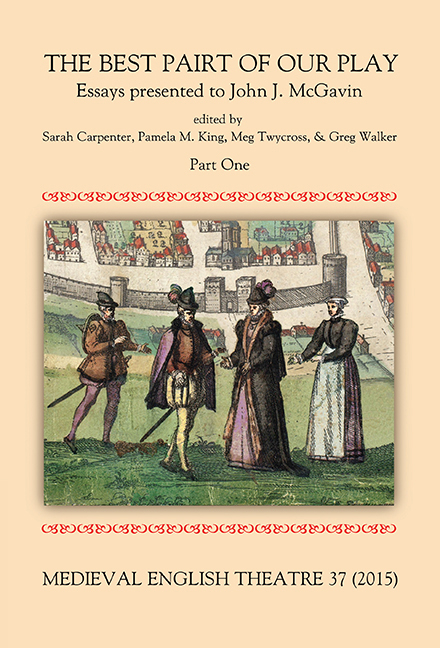Book contents
- Frontmatter
- Contents
- Epigraph
- Editorial
- In honorem John J. McGavin
- John J. McGavin: Bibliography
- The Places of Foolery: Robert Armin and fooling in Edinburgh
- George Bannatyne's ‘Sertane Mirry Interludis’, and Sir David Lyndsay's play
- The Linlithgow Interlude of 1540 and Lyndsay's Satire of the Thrie Estaitis
- Stage Directions in Lyndsay's Ane Satire of the Thrie Estaits
- The Dramatic Voice of William Dunbar
- How to Track a Bear in Southwark: a learning module
- The Digby Mary Magdalen in Performance: a merry peripeteia
- ‘Thus am I Rent on Rode’: taking apart the Towneley Crucifixion
- The Second Shepherds' Play: a play for the Christmas season
- ‘They did not come out of an Abbey in Lancashire’: Francis Douce and the manuscript of the Towneley Plays
- EDITORIAL BOARD (2015)
George Bannatyne's ‘Sertane Mirry Interludis’, and Sir David Lyndsay's play
Published online by Cambridge University Press: 05 March 2016
- Frontmatter
- Contents
- Epigraph
- Editorial
- In honorem John J. McGavin
- John J. McGavin: Bibliography
- The Places of Foolery: Robert Armin and fooling in Edinburgh
- George Bannatyne's ‘Sertane Mirry Interludis’, and Sir David Lyndsay's play
- The Linlithgow Interlude of 1540 and Lyndsay's Satire of the Thrie Estaitis
- Stage Directions in Lyndsay's Ane Satire of the Thrie Estaits
- The Dramatic Voice of William Dunbar
- How to Track a Bear in Southwark: a learning module
- The Digby Mary Magdalen in Performance: a merry peripeteia
- ‘Thus am I Rent on Rode’: taking apart the Towneley Crucifixion
- The Second Shepherds' Play: a play for the Christmas season
- ‘They did not come out of an Abbey in Lancashire’: Francis Douce and the manuscript of the Towneley Plays
- EDITORIAL BOARD (2015)
Summary
Two versions of Sir David Lyndsay's play, commonly known as Ane Satyre of the Thrie Estaitis, have survived. There is the text related to the 1552 Cupar performance, known only from its inclusion in a manuscript compiled by the Edinburgh merchant, George Bannatyne, which he completed in 1568 during the regency of James Stewart, Earl of Moray. And there is the text related to the 1554 Edinburgh performance, known only in the printed form published by the Edinburgh printer, Robert Charteris in 1602, almost fifty years later, in the reign of James VI and I.
Some differences between them are immediately noticeable. Bannatyne's version of Lyndsay's play was one of over four hundred Scottish and English items he gathered for his ‘ballat buik’ from diverse sources. Many were ‘awld’ and ‘mvtillait’ (7), as Bannatyne mentions in his prefacing poem, ‘The Wryttar to the reidaris’, but others were editions of the 1560s. The young compiler gave some prominence to poems with a close family connection, such as those by John Bellenden, whose ‘Benner of Peetie’ [Banner of Compassion], for example, is on the first leaf, its author, family friend as well as royal servitor and influential churchman, there described as ‘the famous and renowmit poet’. Members of the family, including George's father, are mentioned by name and with approval in one of the manuscript's three satiric poems by Robert Sempill, Bannatyne's contemporary. The manuscript's single illustration, the coat of arms of the Bannatynes of Kames, to which George's family was closely connected, appears on folio 375v, sketched in pen at the end of the ‘Proheme’ to the spoof beast fable, ‘Colkelbie Sow’. Shield and fable are perhaps related, since the ‘Proheme’ alludes with formality to ‘gentillmen of he [high] genolegye’ (5), and the three tales that follow offer a parodic deflation of such pretensions. With family associations appearing throughout the manuscript, it seems possible, if unprovable, that Bannatyne's note stating that he has omitted the Acts of Parliament from his final ‘Interlud’ of Lyndsay's play ‘becaus the same is prolixt’ (fol. 210r), had a less earnest side: his father and the printer of James V's Acts, Thomas Davidson, knew each other well, having been appointed joint searchers of foreign ships in 1541, the same year that Davidson became royal printer.
- Type
- Chapter
- Information
- Medieval English Theatre 37The Best Pairt of our Play. Essays presented to John J. McGavin. Part I, pp. 27 - 40Publisher: Boydell & BrewerPrint publication year: 2015



